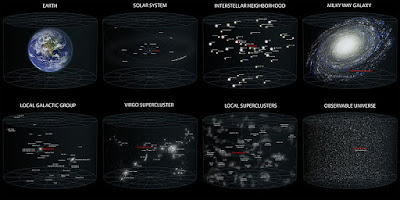"Remember to look up at the stars and not down at your feet. Try to make sense of what you see and wonder about what makes the universe exist. Be curious and however difficult life may seem, there is always something you can do and succeed at. It matters that you don't just give up"- Stephen Hawking.
Quantum Fluctuation : In quantum physics, a quantum Fluctuation or quantum vacuum Fluctuation is the temporary change in the amount of energy in a point in Space, as explained in Heisenberg's " uncertainty principal ". This allows the creation of particle-antiparticle pairs of virtual particles.
So, particle-antiparticle pairs can be created from " nothing ". That is from no particles to two particles, but energy must be provided. So, these particles can be viewed as having been created from the energy.
But energy can neither be created nor destroyed, rather it transformers from one form to another. For instance, Chemical energy can be converted to kinetic energy in the explosion of a stick of Dynamite.
But regarding the fact " The Big Bang created from nothing ", now cosmologist have replayed that the universe formed spontaneously. Recent Scientific theory explain energy can be produce in different subatomic fields by the form of particle's mass. We'll discuss more on this topic in my upcoming chapter.
Inflation : In physical cosmology, cosmic Inflation or just Inflation is a theory of exponential expansion of Space in the early universe. The inflationary epoch lasted from 10−36 seconds after the conjectured Big Bang singularity to sometime between 10−33 and 10−32 seconds after the singularity. Following the inflationary period, the universe continues to expand, but at a less rapid rate.
The Inflation Theory proposes a period of extremely rapid expansion of the universe during it's first few moments. It was developed around 1980 to explain several puzzles with the standard Big Bang theory, in which universe expands relatively gradually throughout it's history. The Big Bang theory is the leading explanation about the Universe as we know it started with a small singularity, then inflated over the next 13.799 billion years to the cosmos that we know.
Cosmic Inflation asked new questions on our very understanding of what the beginning of our universe even means. The Big Bang theory describes the earliest time of our universe amazingly organised. It has made predictions that have been verified beyond reasonable doubt. But two significant problems with the simple model tell us that something strange must have happened in early times, an insane growth that we call Inflation. The observable universe is extremely huge ( approximate diameter 93 billion light years ) that two opposite distant points should never have had time to communicate with each other. And yet, at some point in the distant past they must have been in contact. The cosmic microwave background ( CMB ) tells us that they were once close enough together to become perfectly smoothly mixed. This smoothness of the CMB is known as horizon problem.
We can use the apparent size of the very subtle fluctuations in the CMB to measure the flatness of the fabric of the universe of Space-time. For example, if we draw a triangle on a flat sheet of paper, then it's always 180 degree. Now if we try to draw the same triangle on a surface of a sphere like a football, then the angles become more than 180 degree, which is known as positive curvature. But on a negative curvature hyperbolic plane a saddle like structure they become less. Triangles in 3D Space obey exactly the same rules as on 2D surface, and their geometry measure the curvature of Space.
If we consider the same process in our universe on very large scale then we can find out our universe flat or curve. And proper measurement proves the curvature of our universe is within 0.4 of 1% of perfect flatness.
So what? The universe is flat. No, actually it is extremely weird. An expanding universe doesn't tend to stay flat, even if it starts that way. If our universe is flat to within 0.4 of a percent now, then in the first instant, the universe had to be flat to one pert in 10 to the power of 62.
This flatness problem is just as much of an issue as the horizon problem. Both seem strange if we assume that regular gravity was always the only force affecting the rate of expansion after the initial kick of the Big Bang.
So, now it turns out that we can fix both of these problems with a single, elegant idea called Inflation. So, the idea is start with a universe so crunched down that the entire currently observable part of it was all causally connected. After that, for a very short period of time blow it up much faster than the speed of light. Then most of it appears causally disconnected, at which point Inflation stops and regular expansion takes over. So, universe retains it's once subatomic smoothness and flatness. According to Inflation the universe that we see in a tiny part of a vastly larger universe that itself may well be curved. This Inflation solves both the horizon and flatness problem.
Actually for last 13.799 billion years the universe has expanded by about the same amount that it did during Inflation. Now after those 13.799 billion years still our universe expanding faster that light but this time the culprit is Dark energy. And yet light is the ultimate speed limit. Also the theory of quantum Fluctuation and Inflation has suggested that the Big Bang was not the only cosmic event ever happened. So, from here we can start imagine a multiverse. We'll discuss all those highly likely possibilities on my upcoming chapters. So stay with me.










